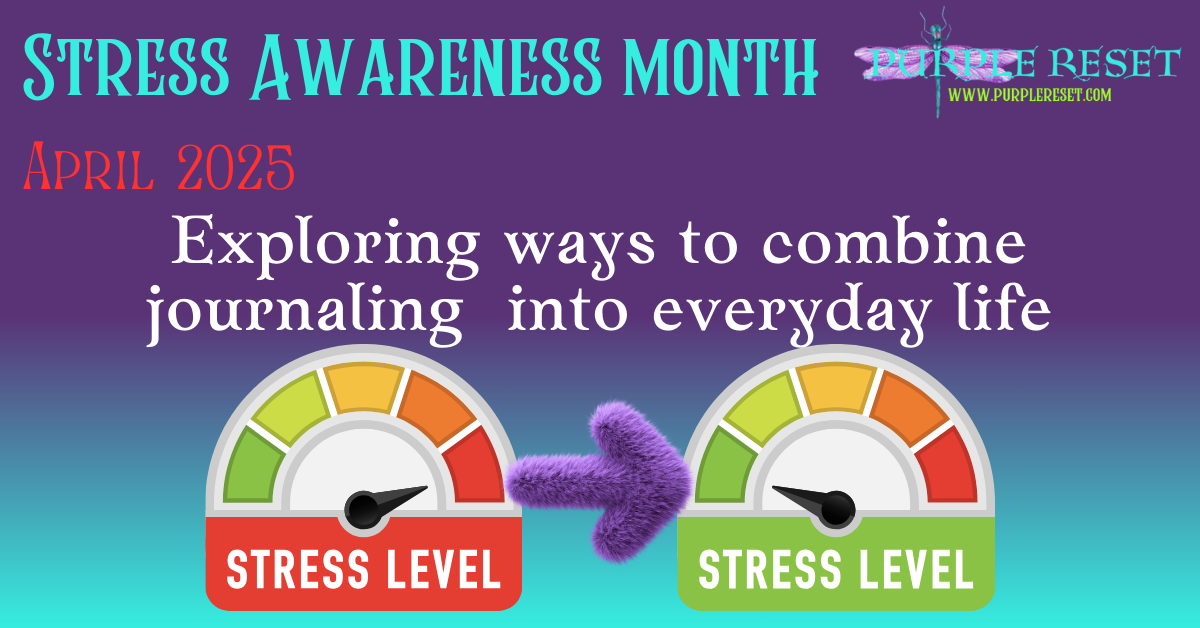Your cart is currently empty!
Journaling for Stress Relief: Unique Activity Combinations

Journaling is a powerful tool for managing stress, processing emotions, and improving mental clarity. However, for some people, especially those who are neurodivergent, the traditional idea of sitting quietly with a notebook might not be the best fit. The good news? Journaling doesn’t have to be a solo, static activity.
By combining it with movement, sensory input, creativity, and structured techniques, journaling can become a dynamic, engaging, and effective practice for reducing stress for both neurotypical and neurodivergent individuals. Here’s how!
1. Journaling + Sensory Stimulation 🖐️🎨🌿
Sensory input can help regulate emotions and enhance focus, making journaling feel more natural and enjoyable.
🔹 Fidget Tools & Tactile Objects
- Use stress balls, fidget cubes, or textured paper while journaling.
- Try scented markers or colorful gel pens for a sensory-friendly experience.
✅ Benefits: Helps with focus, reduces anxiety, and makes journaling more engaging.
🔹 Weighted Blankets & Compression Items
- Wrap in a weighted blanket or wear compression sleeves while writing.
- Try rocking chairs or cocoon chairs for additional comfort.
✅ Benefits: Deep pressure can calm the nervous system and reduce sensory overload.
🔹 Aromatherapy & Scent Association
- Light a candle, use essential oils, or diffuse calming scents while journaling.
- Experiment with different scents like lavender for relaxation or citrus for energy.
✅ Benefits: Scents can create positive associations, making journaling a comforting ritual.
2. Journaling + Movement & Stimming Activities 🏃♂️🎶
For those who need physical activity to regulate emotions or maintain focus, movement-based journaling can be a game-changer.
🔹 Dancing or Stimming to Music
- Put on music and move before or while journaling.
- Rock, tap, or bounce while thinking through journal prompts.
✅ Benefits: Releases stress and boosts dopamine, making it easier to start writing.
🔹 Trampoline or Swing Therapy
- Journal while sitting in a rocking chair, hammock, or on a swing.
- Take breaks to jump on a trampoline or walk around.
✅ Benefits: Vestibular input (movement like swinging) can help with self-regulation and emotional processing.
3. Journaling + Gaming & Interactive Storytelling 🎮📖
For people who struggle with traditional journaling, gamifying the experience can make it more enjoyable.
🔹 Video Games as a Journaling Prompt
- Play a relaxing game (e.g., Animal Crossing, Stardew Valley) and write about your in-game choices.
- Reflect on how game strategies relate to real life.
✅ Benefits: Provides structure and escapism while inspiring self-reflection.
🔹 Choose-Your-Own-Adventure Writing
- Create multiple “paths” in your journal and choose one each day.
- Write as if you’re a fictional character exploring different emotions.
✅ Benefits: Makes journaling more engaging for creative thinkers and reduces pressure.
4. Journaling + Role-Playing & External Processing 🎭🎤
Some people process their thoughts better by speaking them out loud or writing from a different perspective.
🔹 Dictation & Voice Journaling
- Use a speech-to-text app to “journal” by talking.
- Record voice memos and transcribe them later.
✅ Benefits: Perfect for those who process thoughts verbally rather than in writing.
🔹 Role-Playing as Another Persona
- Journal as if you’re your future self giving advice.
- Create an alter-ego or fictional mentor to help guide your thoughts.
✅ Benefits: Provides emotional distance, making it easier to reflect on tough topics.
5. Journaling + Dopamine-Friendly Brain Hacks 🧠🎯
For those with executive dysfunction or ADHD, structured and stimulating methods can make journaling more accessible.
🔹 Body Doubling & Pomodoro Technique
- Set a 5-minute timer and journal in short bursts.
- Journal alongside a friend or virtual co-working session.
✅ Benefits: Helps with motivation and focus, making journaling feel less overwhelming.
🔹 Object-Based Thinking (Sticky Notes & Mind Maps)
- Write ideas on sticky notes and arrange them visually.
- Use a whiteboard or mind maps instead of traditional journaling.
✅ Benefits: Great for non-linear thinkers who struggle with structured writing.
🔹 Novelty & Unconventional Writing Surfaces
- Try invisible ink, glow-in-the-dark pens, or writing on mirrors.
- Journal digitally with voice typing or stylus drawing.
✅ Benefits: Keeps journaling fresh and engaging, preventing boredom.
Final Thoughts: Make Journaling Work for You!
Journaling doesn’t have to be a solitary or rigid practice. By combining it with sensory tools, movement, storytelling, or structured hacks, you can create a journaling experience that truly works for you.
✅ Neurotypical individuals can use these techniques to reduce stress, boost creativity, and stay consistent.
✅ Neurodivergent individuals can use them to self-regulate, increase focus, and make journaling more accessible and enjoyable.
There’s no right or wrong way to journal—only what feels best for you! Which of these combinations are you excited to try? 🌟✍️
Explore my journals designed to support habit-building and self-reflection. Ready to transform your habits and your life? Let’s get started together.
Ready to start your journaling journey? Explore my collection of thoughtfully designed journals to help you make the most of your practice. Whether you’re a beginner or a seasoned journaler, there’s a perfect journal waiting for you. Let’s write your way to clarity, calm, and growth! You can read here why I decided to create this collection.
Fancy joining a journaling community? Then join me on Facebook and/or message me to join my Journaling Whatsapp group
